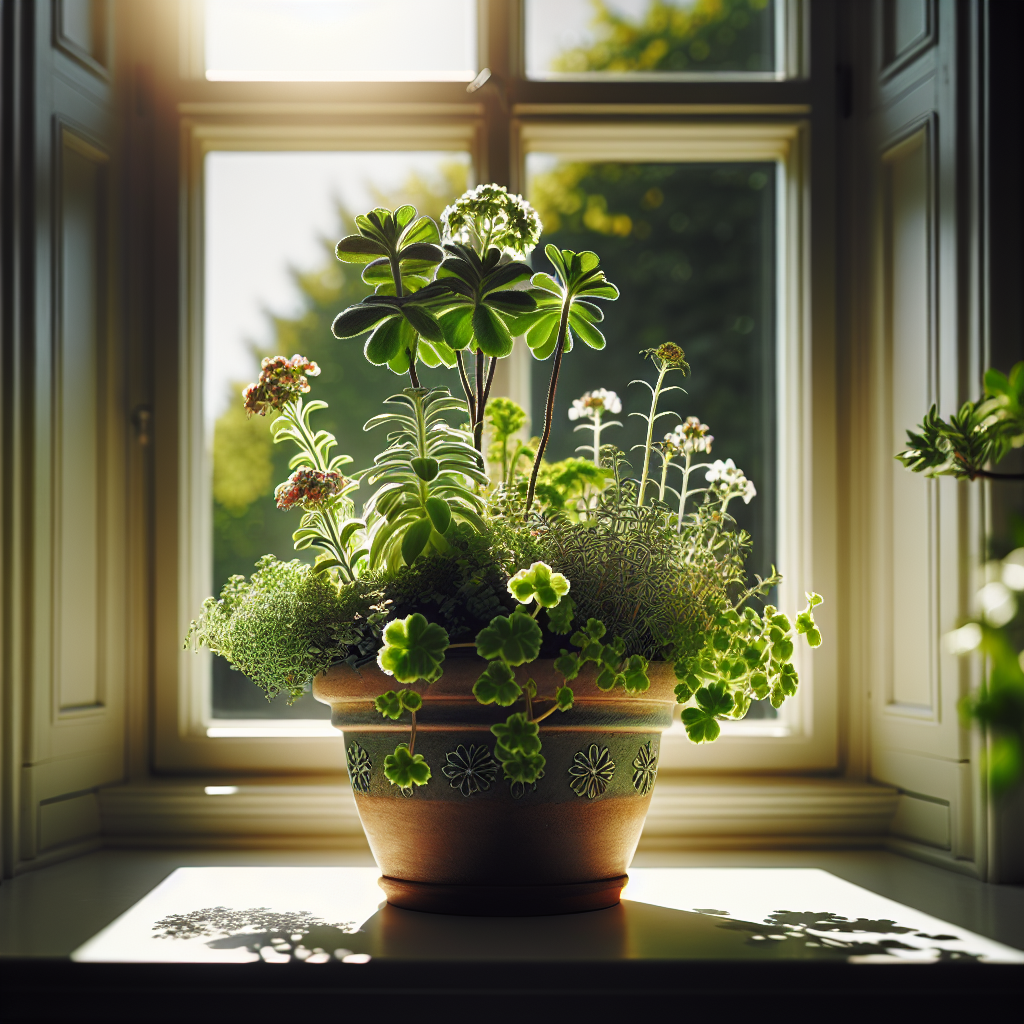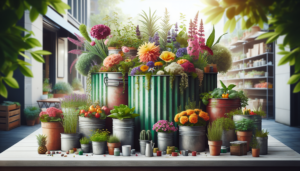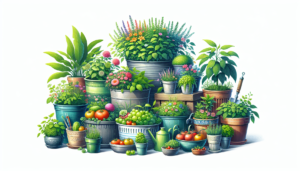
In “The Ultimate Guide to Container Gardening: Notes and Tips,” get ready to explore the wonderful world of container gardening. Whether you’re a seasoned plant enthusiast or just getting started, this guide is packed with valuable insights and practical tips to help you create a flourishing garden in the limited space of containers. From choosing the right plants and containers to nurturing your green companions, this ultimate guide will equip you with all the essential information you need to transform your outdoor or indoor space into a vibrant oasis. So, grab your gardening gloves and let’s embark on this green-thumb adventure together!
Choosing the Right Containers
Consider the size and depth
When choosing containers for your container gardening, it’s important to consider the size and depth of the pots. You want to make sure that the containers are large enough to accommodate the root system of your plants. If the containers are too small, the plants may become rootbound and their growth may be stunted. On the other hand, if the containers are too large, it can lead to over-watering and the soil may become waterlogged. Take into account the mature size of your plants and choose containers that provide enough space for their roots to grow.
Look for containers with drainage holes
Good drainage is crucial for container gardening success. When water cannot drain properly from the containers, it can lead to root rot and other plant diseases. Look for containers that have drainage holes at the bottom to allow excess water to escape. If you come across a beautiful container that does not have drainage holes, you can drill holes into it yourself.
Evaluate the material of the container
Containers for container gardening can be made of various materials, each with its own advantages and disadvantages. Common container materials include plastic, clay, wood, and metal. Plastic containers are lightweight, easy to move, and retain moisture well. Clay containers are porous, allowing for better airflow to the roots, but they can be heavy and may need more frequent watering. Wood containers are natural-looking and provide good insulation for the roots, but they can decay over time. Metal containers may heat up quickly in the sun, so they require extra attention to prevent the roots from getting too hot. Consider your gardening preferences and the needs of your plants when choosing the material of your containers.
Consider the weight and portability
Before purchasing containers for your container garden, consider the weight and portability of the containers. If you plan on moving your garden around, lightweight containers would be more convenient. Plastic containers are usually the lightest option, while clay and metal containers can be heavier. Keep in mind that once the soil and plants are added, the weight of the containers will increase. If you have limited space or need to protect your plants from extreme temperatures or inclement weather, portability may not be a significant factor to consider.
Selecting the Perfect Location
Assess the sunlight requirements
The amount of sunlight your plants need is a crucial factor to consider when selecting the perfect location for your container garden. Most plants require at least 6 hours of direct sunlight each day to thrive, while some may prefer partial or full shade. Observe your outdoor space and consider the sun exposure throughout the day. If your desired location does not receive enough sunlight, consider using shade-loving plants or moving your containers to a more suitable area.
Consider the temperature and climate
Different plants have different temperature and climate requirements for optimal growth. Some plants thrive in warm climates, while others prefer cooler temperatures. Consider the average temperature and climate in your area and choose plants that are well-suited for your specific conditions. If you live in an area with extreme temperatures or frequent temperature fluctuations, consider using containers that provide additional insulation to protect your plants from temperature extremes.
Check for wind exposure
Strong winds can dry out the soil and damage fragile plants. Check the location for potential wind exposure before setting up your container garden. If your desired location is windy, consider using windbreaks such as fencing or strategically placing your containers close to walls or natural barriers. Implementing windbreaks can help create a more sheltered environment for your plants and prevent wind stress.
Evaluate the proximity to a water source
Having a water source close to your container garden is essential for convenient watering. Consider the proximity to a water source when selecting the perfect location. It can be time-consuming and physically demanding to carry water long distances to water your plants. If the location does not have a nearby water source, consider installing a drip irrigation system or using a nearby hose for easy access to water.
Understanding Soil and Drainage
Choose a well-draining potting mix
Choosing the right potting mix is crucial for proper drainage and root health. Use a well-draining potting mix specifically formulated for containers. These mixes are lightweight, provide good aeration to the roots, and allow excess water to flow freely. Avoid using garden soil for your containers, as it is usually too dense and can lead to poor drainage.
Consider the soil pH requirements of your plants
Different plants have different soil pH requirements for optimal growth. Some plants prefer acidic soil, while others prefer alkaline or neutral pH levels. Before planting, determine the soil pH requirements of your plants and adjust the potting mix accordingly. You can test the pH of your soil using a soil testing kit, and if necessary, amend the potting mix with organic matter or additives to achieve the desired pH level.
Add amendments for better drainage and nutrient availability
To further improve drainage and nutrient availability for your plants, consider adding amendments to your potting mix. These amendments can include materials such as perlite, vermiculite, compost, or coconut coir. These additives help create a well-structured and well-aerated growing medium for your container plants.
Monitor moisture levels and water accordingly
Proper watering is crucial for container gardening success. Monitor the moisture levels in your containers regularly and water accordingly. Check the soil moisture by inserting your finger about an inch into the soil. If it feels dry, it’s time to water. Avoid over-watering your plants, as it can lead to root rot and other problems. Remember that the water needs of your plants may vary depending on their species, size, and environmental conditions.
Picking the Right Plants
Select plants suited for container gardening
Not all plants are suitable for container gardening. When picking plants for your container garden, choose those that are well-suited for growing in confined spaces. Look for plants labeled as suitable for container gardening or those that have compact growth habits. Consider the mature size of the plants and how they will fit in your containers without overcrowding.
Consider the mature size of the plants
It’s important to consider the mature size of the plants when selecting and arranging them in your containers. Some plants might initially seem small and suitable for containers, but they can quickly outgrow their space, leading to reproductive problems or stunted growth. Research the mature size of each plant and choose plants that will comfortably fit in the containers at maturity.
Experiment with different plant combinations
Container gardening offers great flexibility and allows you to experiment with different plant combinations. Play with contrasting colors, textures, and plant heights to create visually appealing arrangements. Consider how the plants’ growth habits will complement each other and ensure that their cultural requirements are compatible.
Choose plants based on your gardening goals
When picking plants for your container garden, consider your gardening goals. Are you looking to attract pollinators? Are you interested in growing your own herbs or vegetables? Or are you simply aiming to create a beautiful space? Align your plant choices with your goals to maximize the enjoyment and success of your container garden.
Planting and Transplanting
Prepare the containers and soil before planting
Before planting your container garden, it’s essential to prepare the containers and soil. Clean the containers thoroughly to remove any dirt or debris from previous use. Fill each container with the appropriate potting mix, leaving enough space for the plants and watering. Ensure the soil is evenly moist before planting to provide a conducive environment for the roots.
Carefully transplant seedlings or established plants
When transplanting seedlings or established plants into your containers, handle them with care to minimize transplant shock. Gently remove the plants from their original containers, being mindful not to damage the roots. Create a hole in the potting mix of the new container and carefully place the root ball into it. Gently firm the soil around the roots to secure the plant in its new home.
Avoid over-packing the container
It’s important to avoid over-packing the container with plants. Overcrowding can lead to competition for resources such as water, nutrients, and light, resulting in poor growth and increased susceptibility to diseases. Follow planting guidelines for each plant, ensuring there is enough space for proper root development and airflow.
Follow proper spacing guidelines
Each plant has specific spacing requirements to promote optimal growth and allow for adequate air circulation. Refer to the plant’s labeling or research its spacing needs to ensure you provide sufficient room between plants in your containers. Proper spacing not only helps prevent diseases but also ensures that each plant receives enough sunlight and nutrients to thrive.
Watering Techniques
Learn the specific watering needs of your plants
Understanding the specific watering needs of your plants is crucial for maintaining a healthy container garden. Different plants have different moisture requirements, and it’s important to water them accordingly. Research the watering needs of each plant and adjust your watering routine to satisfy their needs. Some plants may prefer consistently moist soil, while others may prefer to dry out slightly between waterings.
Use an appropriate watering method
When watering your container garden, it’s important to use an appropriate watering method. Avoid using a high-pressure nozzle or a strong stream of water, as it can damage the plants or wash away the soil. Instead, use a gentle watering method such as a watering can or a drip irrigation system. This allows the water to be evenly distributed and ensures that the roots receive sufficient moisture.
Water thoroughly but avoid waterlogging
When watering your containers, aim to thoroughly soak the soil. Water until you see water escaping through the drainage holes at the bottom of the containers. This ensures that the water reaches the entire root system. However, it’s important to avoid waterlogging the soil, as it can lead to root rot and other problems. Allow the soil to dry out slightly between waterings to prevent over-watering.
Monitor moisture levels regularly
Regularly monitoring the moisture levels in your containers is essential for proper watering. Stick your finger about an inch into the soil to check the moisture level. If it feels dry, it’s time to water. If it feels moist, you can wait a little longer before watering. Keep in mind that environmental factors such as temperature and humidity can affect the soil’s moisture, so adjust your watering accordingly.
Feeding and Fertilizing
Understand the nutritional requirements of your plants
To ensure the healthy growth of your container plants, it’s important to understand their nutritional requirements. Different plants have different nutrient needs, and providing the right nutrients is essential for their overall health and productivity. Research the specific nutrient requirements of your plants and choose fertilizers accordingly.
Choose suitable fertilizer types
There are various types of fertilizers available for container gardening, including granular, liquid, and slow-release fertilizers. Granular fertilizers are typically sprinkled on the soil surface and watered in, while liquid fertilizers are mixed with water and applied directly to the plants. Slow-release fertilizers release nutrients gradually over time, providing a continuous supply of nutrients to the plants. Choose a fertilizer type that suits your gardening preferences and the needs of your plants.
Develop a feeding schedule
Establishing a feeding schedule is important for providing your plants with a consistent supply of nutrients. Determine the frequency and amount of fertilizer application based on the specific requirements of your plants. Follow the instructions on the fertilizer packaging and adjust the feeding schedule as needed, considering factors such as the growth stage of the plants and environmental conditions.
Pay attention to signs of nutrient deficiencies
Regularly inspect your plants for signs of nutrient deficiencies. Common signs include yellowing leaves, stunted growth, or poor flowering and fruiting. If you notice any signs of nutrient deficiencies, adjust your feeding schedule or choose a fertilizer that targets the specific nutrient deficiency. A balanced fertilizer can help prevent nutrient deficiencies and ensure the overall health and vitality of your plants.
Pest and Disease Management
Inspect plants regularly for signs of pests
Regular inspections of your container plants are necessary to identify and address pest problems early on. Pests such as aphids, mealybugs, and spider mites can quickly damage plants and spread to neighboring containers. Look for signs of chewed leaves, holes in foliage, or visible pests on the plants. Promptly address any pest issues to prevent further damage.
Implement preventive measures
Prevention is key when it comes to pest and disease management. Implement preventive measures to minimize the risk of infestations and diseases in your container garden. Avoid overcrowding plants, provide adequate air circulation, and practice good gardening hygiene by removing dead leaves and debris. Additionally, be cautious when introducing new plants to your garden, as they may carry pests or diseases.
Identify common garden pests and diseases
Educate yourself about common garden pests and diseases that can affect container plants. Learn to identify the signs and symptoms of these problems. Common pests include aphids, whiteflies, and snails, while common diseases include powdery mildew and fungal infections. By being aware of these issues, you can take appropriate actions to control and prevent them.
Use organic or chemical control methods
When dealing with pests and diseases, you have the option to use organic or chemical control methods. Organic methods rely on natural solutions such as insecticidal soaps, neem oil, or biological controls like beneficial insects. Chemical control methods involve the use of pesticides. Choose the method that suits your gardening philosophy and consider the potential impact on beneficial insects and the environment.
Maintaining Container Gardens
Prune and trim plants as needed
Regular pruning and trimming help maintain the shape and health of your container plants. Remove dead or damaged foliage, prune back overgrown branches, and deadhead spent flowers. Pruning also encourages bushier growth and better airflow, reducing the risk of diseases. Use clean and sharp pruning tools to avoid damaging the plants.
Monitor for overcrowding
As your container plants grow, they may become overcrowded and compete for resources. Monitor the growth of your plants regularly and address any issues with overcrowding. Thin out plants that have outgrown their space or consider repotting them into larger containers. Proper spacing allows each plant to receive adequate light, water, and nutrients for optimal growth.
Divide or repot plants when necessary
Container plants can become rootbound over time, where the roots densely fill the container and restrict growth. When you notice this happening, it’s essential to divide or repot the plants. Gently remove the plant from its container, tease out the roots, and either divide the plant into smaller sections or repot it into a larger container with fresh potting mix.
Remove spent flowers and foliage
To keep your container garden looking its best, regularly remove spent flowers and foliage. Deadheading, or removing faded flowers, promotes continuous blooming and prevents the plants from putting energy into seed production. Additionally, regularly remove yellowing or diseased foliage to prevent the spread of diseases and maintain the overall health of your plants.
Troubleshooting Common Issues
Addressing yellowing leaves
Yellowing leaves can be a sign of various issues, including nutrient deficiencies, over-watering, or pest infestations. Assess the overall health of your plants, check the soil moisture levels, and inspect for signs of pests. Adjust your watering and fertilizing practices as needed, and promptly address any pest problems. If the issue persists, consult gardening resources or seek advice from local experts.
Dealing with rootbound plants
Rootbound plants occur when the roots outgrow the container and become densely packed. This can lead to stunted growth and poor plant health. To address rootbound plants, gently remove the plant from its container, loosen the roots, and divide or repot them into a larger container. Carefully spread out the roots and provide fresh potting mix to support new growth.
Preventing and managing mold and mildew
Mold and mildew can be problematic in container gardens, especially in humid or poorly ventilated conditions. To prevent mold and mildew, provide adequate air circulation around your plants and avoid over-watering. If you notice signs of mold or mildew, remove affected leaves, improve air circulation, and consider using organic fungicides or other appropriate treatments.
Solving nutrient deficiencies and imbalances
Nutrient deficiencies or imbalances can cause poor growth, yellowing leaves, or other visible signs in your container plants. Address these issues by adjusting your fertilizing practices to provide the necessary nutrients in the appropriate ratios. Conduct soil tests to determine the exact nutrient deficiencies or seek guidance from local gardening experts to ensure the proper nourishment of your plants.
By following these guidelines for choosing containers, selecting the perfect location, understanding soil and drainage, picking the right plants, planting and transplanting correctly, employing proper watering techniques, applying appropriate feeding and fertilizing practices, managing pests and diseases, maintaining your container garden, and troubleshooting common issues, you can have a successful and thriving container garden. Container gardening offers endless possibilities for enjoying plants in any space, whether you have a small balcony, a sunny patio, or a window sill. So get started and create your own vibrant and beautiful container garden today!







